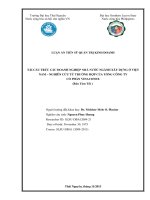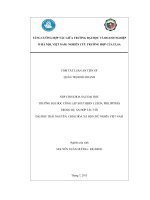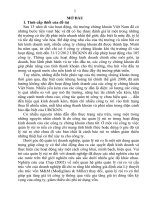6 trich yeu luan an ta
Bạn đang xem bản rút gọn của tài liệu. Xem và tải ngay bản đầy đủ của tài liệu tại đây (1.74 MB, 5 trang )
SOCIALIST REPUBLIC OF VIETNA}
MINISTRY OF EDUCATION AND TRAINING
Independence - Freedom - Happines
NATIONAL INSTITUTE OF DRUG
QUALITY CONTROL
DISSERTATION ABSTRACT
1. Introduction
Name of Ph.D. candidate: Nguyen Thi Phuong Thao
Topic of dissertation: Research on isolation and establishment of active
constituents as reference standards for improvement of quality standards of the
Vietnamese herbs Siegesbeckia orientalis and Cleistocalyx operculatus.
Specialization: Drug Quality Control and Toxicology
Code number: 9720210
Name of academic institute: National Institute of Drug Quality Control
2. Summary
2.1. Objectives
The objectives of this Ph.D. thesis include:
- Objective 1: Extraction, isolation and purification of compound darutoside
from the herbs of Siegesbeckia orientalis; and 2',4'-dihydroxy-6'-methoxy-3',5'dimethylchalcon (CO1) from Cleistocalyx operculatus with purity and quantity
merit to establish primary reference standards.
- Objective 2: Development of quality of materials for establishment of
reference standards: validation, specification and testing methods for the two
compounds as materials.
- Objective 3: Establishment of two quantitative primary reference standards:
darutoside and COI.
- Objective 4: Development and validation a method for simultaneous
qualitative and quantitative analysis of kirenol and darutoside in Herba
Siegesbeckiae; and a method for qualitative and quantitative CO1 in Flos and
Folium Cleistocalysis operculati.
2.2. Contents and methods
2.2.1. Contents of this PhD thesis
- Extraction,
compounds
isolation,
darutoside
purification
(from
and
structural
Siegesbeckia
determination
orientalis)
and
CO1
of two
from
(Cleistocalyx operculatus) for establishment of primary reference standards.
1/5
- Proposal of a dataset identification for darutoside and CO1: melting point,
specific optical rotation, spectra data (UV, IR, MS, NMR).
and validation of an analytical method
- Development
for determination of
organic, inorganic and volatile impurities of raw materials darutoside and COI.
- Proposal of quality criteria for raw materials to establish primary reference
standards for darutoside and CO1.
- Establishment of two primary reference standards: darutoside and CO1.
- Development and validation a HPLC method for simultaneous qualitative and
quantitative analysis of kirenol and darutoside in Herba Siegesbeckiae; identify
and quantify 08 samples of Herba Siegesbeckiae collected at different places in
Vietnam, and at different times.
- Development and validation a HPLC method for qualitative and quantitative
analysis of COI in Flos Cleistocalysis operculati and Folium Cleistocalysis
operculate; identify and quantify 08 samples of Flos Cleistocalysis operculati
and 08 samples of Folium Cleistocalysis operculati collected at different places
in Vietnam, and at different times.
2.2.2. Methods
“Extraction,
isolation,
purification
and
structural
confirmation
of pure
substances
- Extraction by maceration with ethanol 96% at room temperature. The solvent
was evaporated under reduced pressure to yield an ethanol extract. The crude
extract was suspended in HO and sequentially partitioned with n-hexane, and
then ethyl acetate to obtained the ethyl acetate extract.
- Isolation of substances by column chromatography (silica gel, RP-C18, LH20)
and thin layer chromatography.
- Purification of constituents (darutoside and CO1) by preparative HPLC using
RP-C18 column.
- Determination of the purity of raw materials by peak area normalization
HPLC/DAD.
- Structural determination by nuclear magnetic resonance (NMR), including 1-
dimensional ('H-NMR, C-NMR, DEPT) and 2-dimensional (HSQC, HMBC,
COZY, NOESY) spectroscopy, high-resolution mass spectroscopy (HR-MS),
infrared spectroscopy (IR).
“+ Establishment of primary reference standards
- Proposal of identification dataset for chemical standard materials: 'H NMR,
3C NMR, HR-MS, IR, UV-VIS, melting point, ...
2/5
- Development and validation of analytical methods for determination of
chromatographic purity and related impurity content by HPLC/DAD, inorganic
impurities by sulfated ash test and volatile impurities by TGA.
- Proposal of quality criteria for materials used for establishing quantitative
primary reference standards.
- Establishment of primary reference standards according to the instruction of
ISO GUIDE 35 and ISO 17034.
** Development and validation of a HPLC method for simultaneous qualitative
and quantitative analysis of kirenol and darutoside in Herba Siegesbeckiae.
- Sample preparation: verifying the suitability of extraction method described in
CP2015 (monograph “Herba Siegesbeckiae” for “Assay of kirenol”) for Herba
Siegesbeckiae samples collected in Vietnam.
- Development and validation of a HPLC method for simultaneous qualitative
and quantitative analysis of kirenol and darutoside in Herba Siegesbeckiae
following ICH Q2(R1) and AOAC guidelines.
s*Development and validation of a HPLC method for qualitative and
quantitative analysis of CO1 in Flos Cleistocalysis operculati and Folium
Cleistocalysis operculati
- Sample preparation: carry out the extraction methods using methanol or ethyl
acetate heat under reflux or in sonicate bath. Choose the most safe, economic
and time-saving method.
- Validation of HPLC method that has been used in assay of CO1 in raw material
in Flos
compound, for qualitative and quantitative analysis of COl
Cleistocalysis operculati and Folium Cleistocalysis operculati following ICH
Q2(R1) and AOAC guidelines.
2.3. Main results
“»
Extraction, isolation, purification and structural confirmation of darutoside
and CO1
- Dried aerial parts of S. orieantalis (20 kg) were extracted by maceration with
ethanol 96% at room temperature. The solvent was evaporated under reduced
pressure to yield an ethanol extract (1.4 kg). The crude extract was then
suspended in water and partitioned with ethyl acetate. The ethyl acetate fraction
(610 g) was chromatographed by using a silica gel column, eluting with a
dichloromethane - methanol gradient system (100:1 to 0:1), to give 8 fractions
(HTE1-HTE8) according to TLC analysis results. Fraction 5 (21.3 g) was
subjected to RP-C18 column (3 x 80 cm), stepwise gradient of methanol - water
3/5
(1:1 to 4:1) to afford 6 fractions (HTESA-HTESF). Fraction HTESC (3.2 g) was
subjected to RP-Cjg column (3 x 80 cm) with mobile phase of methanol - water
(2:1) to obtain darutoside (790 mg). The isolation was repeated three times to
yield 2.37 g of darutoside. The obtained substance was subjected to spectral
measurement (NMR, HR-MS, IR) for structural identification as darutoside.
- Dried flower-bud of C. operculatus (10 kg) were extracted by maceration
with ethanol 96% at room temperature. The solvent was evaporated under
reduced pressure to yield an ethanol extract (1.2 kg). The crude extract was then
suspended in water and sequentially partitioned with n-hexane, then ethyl
acetate. The ethy] acetate fraction (450 g) was chromatographed by using a silica
gel column, eluting with a n-hexane —ethyl acetate (8:1 then 4:1), to give CO1
fractions (20,7 g) according to TLC analysis results. Fraction CO1 (6 g) was
subjected to HPLC preparative with RP-C18 column with mobile phase of
acetonitrile - water (7:3) to obtain CO1 (2.8 g). The obtained substance was
subjected to melting point measurement and spectral measurement such as
NMR, HR-MS, IR for structural identification as CO1.
** Proposal of quality criteria for the raw materials used for quantitative
reference standards
Base on the results of development and validation of the HPLC methods to
test related substances and chromatographic purity in compound raw materials
(CO1 and darutoride) as well as testing results of these materials by melting
point, volatile impurities, inorganic impurities proposed specification and
testing methods for these two raw materials.
«+
Establishment of primary reference standards
The establishment of chemical primary reference standards was carried out
according to the instructions of ISO 17034 and ISO GUIDE 35, assigned content
of a chemical reference standard according to the guideline of World Health
Organization
(WHO),
International
Pharmacopeia
(Int’P)
European
Pharmacopeia (EP). 90 vials of darutoside primary reference standard (lot No.
E0121382.01, content 95.16 + 0.05% on the as is basis) were monitored for 9-
months
stability.
76
vials
of COl
primary
reference
standard
(lot No.
E0120358.01, content 95.52 + 0.05% on the as is basis) were monitored for 30-
months stability.
“+ Development and validation HPLC method for simultaneous qualitative and
quantitative analysis of kirenol and darutoside in Herba Siegesbeckiae
- Darutoside reference standard has been successfully utilized to develop and
validate the HPLC method for simultaneous assay of kirenol and darutoside in
4/5
Herba Siegesbeckiae. This analytical method was fully validated in accordance
with guidelines of ICH Q2 (R1) and AOAC
Introduction to Standard Method
Performance Requirements — Appendix F.
- The validated method was applied to test 8 samples of of Herba
Siegesbeckiae collected in different places, at different times within Vietnam.
The results showed that the content of kirenol were < LOD — 0.43 mg/g and
darutoside were 0.48 — 2.60 mg/g calculated on dried basis.
“* Development and validation HPLC method for qualitative and quantitative
analysis of CO1 in Flos Cleistocalysis operculati and Folium Cleistocalysis
operculati
- Established reference standard CO1 has been successfully utilized to
develop and validate the HPLC method for assay of CO1 in Flos Cleistocalysis
operculati and Folium Cleistocalysis operculati. This analytical method was
fully validated in accordance with guidelines of ICH Q2 (RI) and AOAC
Introduction to Standard Method Performance Requirements — Appendix F.
- The validated method was applied to test 8 samples of of Flos Cleistocalysis
operculati and 8 sample Folium Cleistocalysis operculati, collected in different
places, at different times within Vietnam. The results showed that the content of
COI in flower-bud were 6.87-10.32 mg/g and leaves were 1.77 — 5.28 mg/g
calculated on dried basis.
Hanoi, March 20", 2023
THE SCIENTIFIC ADVISORS
DOCTORAL
(Signature and full name)
CANDIDATE
(Signature and full name)
Assoc.Prof. Phuong Thien Thuong, Ph.D. Nguyen Thi Lien, Ph.D.
5/5
Nguyen Thi Phuong Thao









